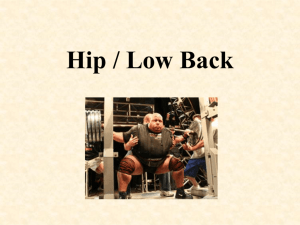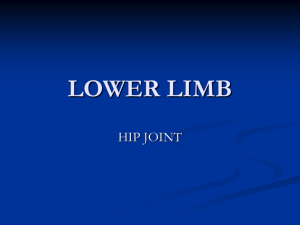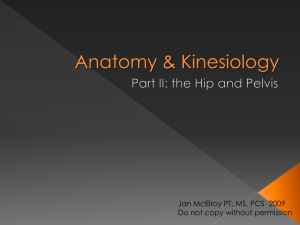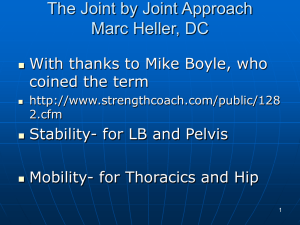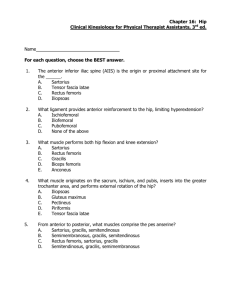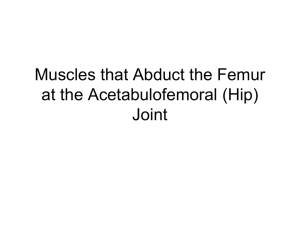Preview
advertisement
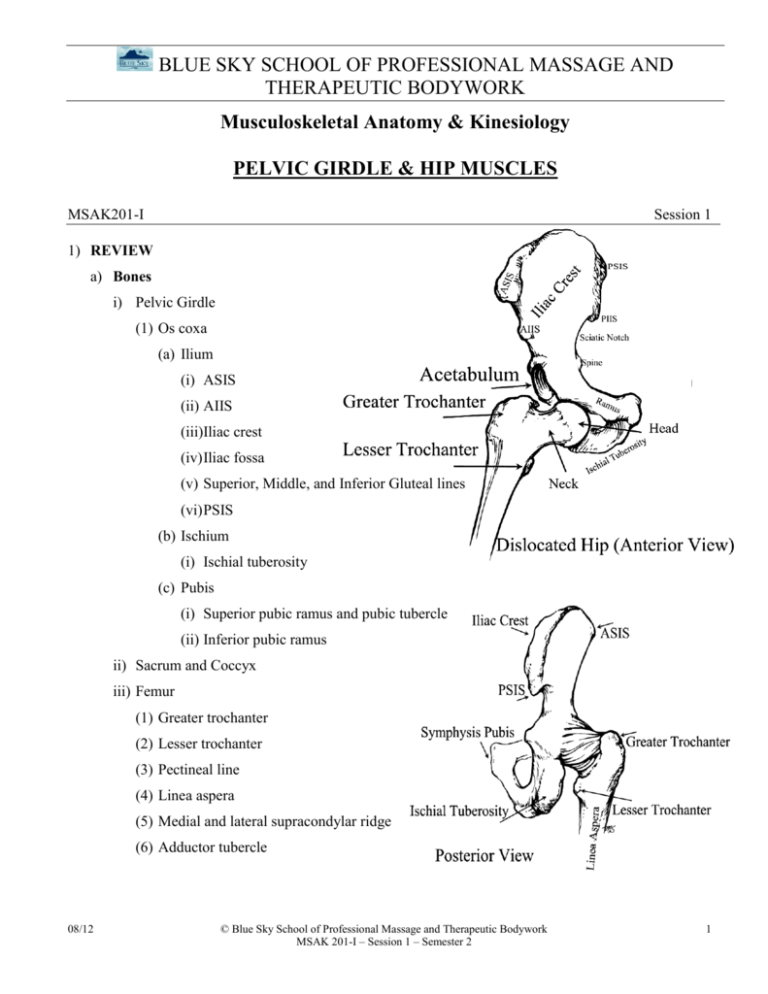
BLUE SKY SCHOOL OF PROFESSIONAL MASSAGE AND THERAPEUTIC BODYWORK Musculoskeletal Anatomy & Kinesiology PELVIC GIRDLE & HIP MUSCLES MSAK201-I Session 1 1) REVIEW a) Bones i) Pelvic Girdle (1) Os coxa (a) Ilium (i) ASIS (ii) AIIS (iii)Iliac crest (iv) Iliac fossa (v) Superior, Middle, and Inferior Gluteal lines (vi) PSIS (b) Ischium (i) Ischial tuberosity (c) Pubis (i) Superior pubic ramus and pubic tubercle (ii) Inferior pubic ramus ii) Sacrum and Coccyx iii) Femur (1) Greater trochanter (2) Lesser trochanter (3) Pectineal line (4) Linea aspera (5) Medial and lateral supracondylar ridge (6) Adductor tubercle 08/12 © Blue Sky School of Professional Massage and Therapeutic Bodywork MSAK 201-I – Session 1 – Semester 2 1 iv) Patella v) Tibia (1) Tibial tuberosity vi) Fibula (1) head b) Joints i) Sacroiliac joints ii) Symphysis pubis iii) Sacrocyccygeal joint iv) Lumbosacral joint v) Acetabulofemoral joint c) Terminology i) Pes Anserine area – located on proximal medial tibia includes the attachments of Sartorius, Gracilis, and Semitendinosus 2) HIP MUSCLES a) Iliopsoas i) Iliacus (1) Origin: Iliac fossa. (2) Insertion: Lesser trochanter of femur. (3) Fiber Direction: Superior to inferior. (4) Actions: (a) Flexion of hip. (b) External rotation of hip. (c) Tilt pelvis anteriorly. (5) Notes / relationship to other musculoskeletal structures: (a) A chronically tight Iliacus anteriorly tilts the pelvis causing the lumbar curve to become hyperlordotic. (b) Most of the Iliacus is not palpable. 08/12 © Blue Sky School of Professional Massage and Therapeutic Bodywork MSAK 201-I – Session 1 – Semester 2 2 ii) Psoas Major (1) Origin: TP’s, bodies and discs of L1-L5. (2) Insertion: Lesser trochanter of femur. (3) Fiber Direction: Superior to inferior. (4) Actions: (a) Flexion of hip. (b) Flexion of trunk. (c) External Rotation of hip. (d) Tilt pelvis anteriorly. (5) Notes / relationship to other musculoskeletal structures: (a) The Psoas major is deep but palpable. (b) Often the Iliacus and Psoas major are referred to as the Iliopsoas muscle because of their common distal attachment. (c) A chronically tight Psoas major anteriorly tilts the pelvis causing the lumbar curve to become hyperlordotic. iii) Psoas Minor (1) Origin: Bodies and TPs of L1. (2) Insertion: Superior ramus of pubis. (3) Fiber Direction: Superior to inferior. (4) Actions: (a) Assists to create lordotic curve. (b) Tilt pelvis posteriorly. (5) Notes / relationship to other musculoskeletal structures: (a) The Psoas minor is absent in 60% of the population. (b) Psoas minor is fairly weak and usually not considered to be a very important muscle. b) Gluteus Maximus i) Origin: Posterior sacrum, coccyx, posterior iliac crest, sacrotuberous and sacroiliac ligaments ii) Insertion: (1) Iliotibial band. (2) Gluteal tuberosity of femur. 08/12 © Blue Sky School of Professional Massage and Therapeutic Bodywork MSAK 201-I – Session 1 – Semester 2 3 iii) Fiber Direction: Superior to inferior laterally. iv) Actions (1) Extension of hip. (2) External rotation. (3) Abduction of hip (upper 1/3 fibers) (4) Adduction of hip (lower 2/3 fibers). v) Notes / relationship to other musculoskeletal structures: (1) There are two muscles that attach into the iliotibial band: Gluteus maximus and the TFL. (2) Gluteus maximus is the largest muscle in the human body. c) Gluteus Medius i) Origin: Iliac crest between superior and middle gluteal lines. ii) Insertion: Greater trochanter of femur. iii) Fiber Direction: Superior to inferior laterally. iv) Actions (1) Abduction of hip. (2) Medial rotation of hip. (3) Anterior fibers flex. (4) Posterior fibers extend. v) Notes / relationship to other musculoskeletal structures: (1) 1/3 of the Gluteus medius is deep to the Gluteus maximus. d) Gluteus Minimus i) Origin: Posterior ilium between middle and inferior gluteal lines. ii) Insertion: Greater trochanter of femur. iii) Fiber Direction: Superior to inferior laterally. iv) Actions: (1) Abduction of hip. (2) Medial rotation of hip. (3) Flexion of hip. v) Notes / relationship to other musculoskeletal structures: (1) The attachments of Gluteus minimus are difficult to differentiate from the Gluteus medius. 08/12 © Blue Sky School of Professional Massage and Therapeutic Bodywork MSAK 201-I – Session 1 – Semester 2 4 e) Deep Six Lateral Rotator Muscles i) Piriformis ii) Superior Gemellus iii) Obturator Internus iv) Inferior Gemellus v) Obturator Externus vi) Quadratus Femoris vii) As a group: (1) Origin: Anterior sacrum, ischial spine, ischial tuberosity, superior & inferior pubic rami, obturator foramen. (2) Insertion: Greater trochanter of femur. (3) Fiber Direction: Horizontally in the transverse plane. (4) Action: External Rotation of hip. (5) Notes / relationship to other musculoskeletal structures: (a) Piece Goods Often Go On Quilts. 3) Motions of Hip 08/12 ACTION ROM AGONIST SYNERGIST Flexion 120° Iliacus Psoas Major Rectus femoris Sartorius Adductor longus Adductor magnus Pectineus Extension 30° Gluteus maximus Biceps femoris Semimembranosus Semitendinosus Adductor magnus Adduction 20 – 30° Adductor longus Adductor magnus Gracilis Gluteus maximus Pectineus Abduction 45 – 50° Gluteus medius Gluteus minimus Sartorius Tensor Fasciae latea External Rotation 45° Piriformis Deep Six Sartorius Iliopsoas Gluteus Maximus Internal Rotation 35° Gluteus medius Gluteus minimus Adductor magnus Adductor longus Tensor fasciae latae © Blue Sky School of Professional Massage and Therapeutic Bodywork MSAK 201-I – Session 1 – Semester 2 5

